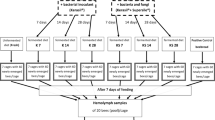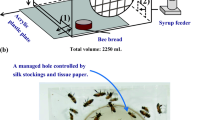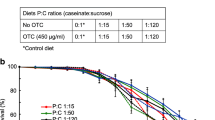Summary:
The flow of incoming nectar in honeybee (Apis mellifera L.) colonies was simulated by feeding a sucrose solution labeled with a novel protein (rabbit IgG) marker and then analyzing bee and colony samples using an enzyme-linked immunosorbant assay (ELISA). The labeled sucrose solution was quickly transported to food storage and brood combs. Within 2h, equal percentages of worker bees from food storage combs, nurse bees and nectar samples tested positive for the marker. Percentages of nurse bees and larvae testing positive also were equal within the first 2 h of feeding it to a colony and these percentages increased over time. Our results suggest that workers with nectar loads deposit them into cells on either food storage or brood comb with equal frequency. The labeled sucrose solution transported to the brood comb is subsequently used by nurse bees to feed larvae. How the deposition of incoming nectar in brood comb might possibly integrate the activities of foragers and nurse bees is discussed.
Similar content being viewed by others
Author information
Authors and Affiliations
Additional information
Received 1 October 1999; revised 3 April 2000; accepted 2 May 2000.
Rights and permissions
About this article
Cite this article
DeGrandi-Hoffman, G., Hagler, J. The flow of incoming nectar through a honey bee (Apis mellifera L.) colony as revealed by a protein marker. Insectes soc. 47, 302–306 (2000). https://doi.org/10.1007/PL00001720
Issue Date:
DOI: https://doi.org/10.1007/PL00001720




